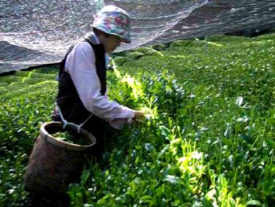What is Shade-Grown Tea?

What is Shade-Grown Tea? The shade-growing method was developed at the end of the Edo era, in the 1860’s. About three weeks before the May harvest, the gardens are shaded over. They were once covered in rice straw, but todays growers use a black plastic mesh or tana.
Some of loose leaf green teas from Japan and all matcha require the leaves to be at least partially shade grown. The shading used for longer periods of time will have a much higher level of chlorophyll and amino acids. That is why shade-grown teas will have a much brighter jade hue to the liquor.
Increasing the length of time of shading will also increase the level of caffeine, as well as the level of theanine. Theanine is the component in green tea that is responsible for the sweet, savory flavor. Teas that have a higher content of theanine will have a sweeter flavor, and are considered to be a higher grade.
On the flip side of the shade aspect is the exposure to sunlight which increases the level of Vitamin C, as well as the level of tannins. Tannins are the components in tea that give you a light astringent taste, much as you would find in a glass of wine. It is also responsible for giving the liquor a more full-bodied flavor, yet smooth finish.
Most of the time your shade-grown teas can be found in Japan. Teas such as Tamaryokucha, Gyokuro, and Matcha are all partial to full shade.
Just remember this month is the time to enjoy our latest Shincha harvest. Our Hashiri Shincha was plucked from Uchimaki, Shizuoka Prefecture. Hashiri means the “first (harvest or catch) of the season”. Get it while it’s available. Our stock usually dwindles within a six week period, then that’s it until this time next year.
Source: en.wikipedia.org/wiki/Matcha

